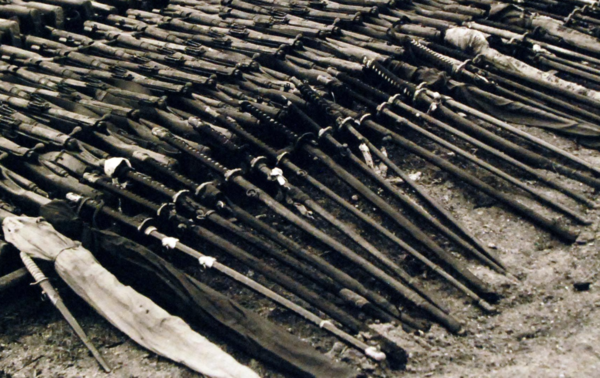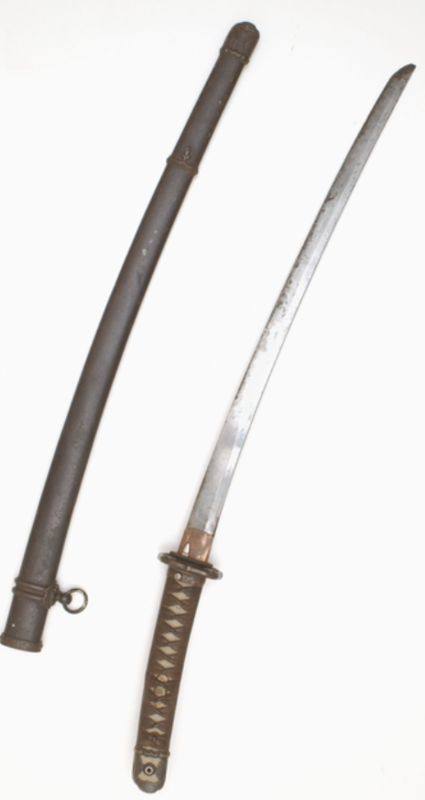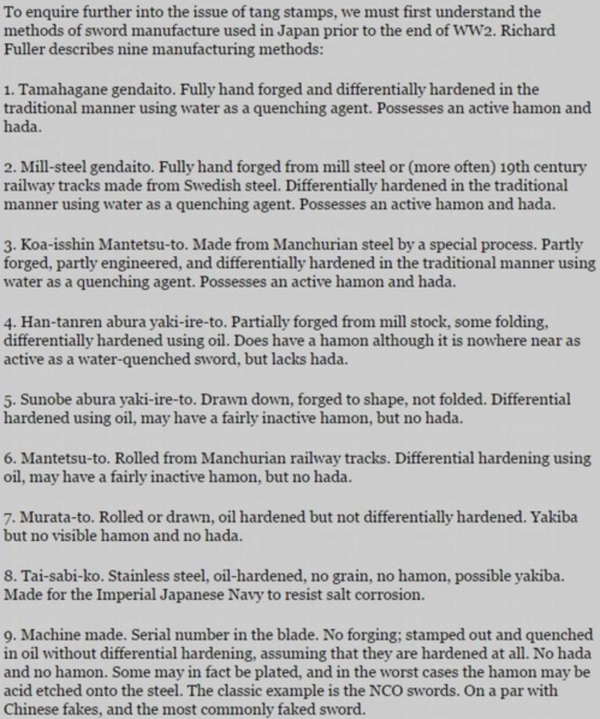
Droocoo
Members-
Posts
46 -
Joined
-
Last visited
Content Type
Profiles
Forums
Events
Store
Downloads
Gallery
Everything posted by Droocoo
-
Superb blade Neil
-
Thanks for all of the responses, I am glad that this stimulated some discussion
-
Three is a crowd! I am going to embark on writing up the sword's history soon, after I learn a little more about RJT. I have been reading through some excellent threads here and on other forums linked from here.
-
Bruce, Have you got a photograph of that sword? Andrew
-
Showato or Gendaito? Help with nie nioi
Droocoo replied to Infinite_Wisdumb's topic in Military Swords of Japan
Chris and Jesse, Thank you for your explanations. I am half way through reading your website on RJT Gendaito Chris, and am keeping your remarks in mind when making my way through the content. I have been looking at higher quality blades/nihonto to increase my pattern recognition. Some of these points I have managed to deduce myself, but the activity of the hamon has been something that has been hard to quantify. You have done an excellent job putting this into words. If anyone else has further contribution, I would love to hear. Andrew -
Showato or Gendaito? Help with nie nioi
Droocoo replied to Infinite_Wisdumb's topic in Military Swords of Japan
Can I just ask (apart from tang signature), from the blade itself what type of attributes distinguish gendaito from showato? -
I use beeswax on my leather goods, and it does a pretty good job of keeping them moist and supple
-
The recycling of these blades is what surprised me
-
An interesting discussion - I suppose if war materials and labour were an issue, then potentially the wooden scabbard has some drawbacks. After all, it is more labour intensive and cannot be simply cast like a metal saya can. I would have thought that metal sayas provided better protection particularly from crushing forces than wooden/lacquered scabbards due to the tensile strength of metal. This would be particularly relevant when soldiers had an expensive, historic or ancestral blade mounted. The Rinji katana that I possess, has a high-quality blade but is mounted in a lacquer saya. Sure it is lighter, but metal does provide better protection when you have gone to all of this trouble to purchase an expensive blade. I am aware that Rinji swords rarely have metal sayas, but that is beside my point. Furthermore, theoretically a painted metal saya somewhat negated the requirement for a leather combat cover, requiring less protection from moisture than a wooden saya. I am also aware that a lot of troops carried metal sayas inside leather coverings. Food for thought, Andrew
-
Bruce, Aren't those excerpts great? I wonder what became of those swords, and what service they saw both in China and the Second World War. The sword "fete" and demonstration that Nick describes is also very novel and interesting. There were many Western examples of this as commissioned officers took to Saville Row to purchase uniforms, and Sheffield cutlers for swords. I can imagine the excitement of young men as they fitted inherited blades before mobilising for war. I find it interesting that Japanese shops carried antique blades to sell to troops, rather than these being solely inherited. The concept that an old blade could still outclass a new blade is very interesting. Andrew
-
Appears to me to be a genuine Type 19. Any more photos of the handguard?
-
Thankyou Neil and John, I have purchased a copy of Dawson’s book which is on its way! Yes that was partly why I asked. The saya on my sword is lacquer with an RJT blade and an iron tsuba. The picture is pointing towards a premium variant optimised for combat. However, it is fascinating that the metal scabbards were not preferred given the hard operating conditions that these swords endured. I wonder if this has to do with rust and moist climates. I don’t think that I have ever seen a Rinji sword in leather mounts if I am honest? Kind Regards, Andrew
-
Neil, We both know which sword we are talking about! Yes that is totally plausible and the fact that swords were upgraded even towards the end of the war, shows their intention to be used in combat. There is an argument to be made that swords with standard blades/Showato could have been surplus, but those with RJT are more likely to have been issued. My next question has been triggered; did they government acquire blades from manufacturers or did individual personnel on a private basis? Surely the government would have requestioned all swordmakers’ blades as their own in such a time of crisis? Kindest Regards, Andrew
-
Hi all, Exploring further differences between Type 3 and Type 98 officers' swords, I have noticed that many of the Type 3 swords seem to be fitted with wooden, lacquered sayas whereas Type 98's and indeed Type 95's are fitted with painted metal sayas. To me, this is somewhat confusing. What was the more desirable saya; the lacquer or metal variety? The lacquer may have taken significantly more care to apply in coats, but was less durable than the metal. If this was the case, why then was the Type 95 given a metal saya and not a lacquered one? After all, the saya in many instances would be covered by a leather combat covering. Hope someone can shed some light, Andrew
-
Pretty interesting John, still no sign of any Rinji there! Andrew
-
Hi all, I was having a read through the Type 3/Type 0/Rinji sword threads previously discussed and it got me thinking about the types of swords used in combat and in the field. What was being debated in these threads, was whether officers preferred Type 98 'fancy' koshirae such as pierced brass tsubas, or whether it was more practical to have the solid, iron tsubas and koshirae of the Rinji sowrds when in the field. Some hypotheses were made that staff officers and those out of the front line may have preferred the Type 98, whereas those who actually took part in combat may have preferred the Rinji variety. In an effort to approach this matter, I searched for photographs of swords either being used or being captured. The problem with the latter, is that usually these swords are massed and could either have been taken from staff or field officers. The former brought up photographs of Japanese officers, cheering after victory in battle with swords drawn. None of the photographs that I saw were of sufficient quality to determine the tsubas or koshirae used on the swords they depicted. Photographs of atrocities committed by Japanese troops, however, did give some answers. There is no political impetus behind this post, and I would like to focus purely on the sword fittings being discussed here. There were many atrocities committed in Manchuria, with Lieutenant Toshiaki Mukai participating in one such. Without going into detail, we can see that he indeed was carrying a Type 98 in the field (keep in mind the Rinji had not been 'invented' yet). This sword is displaced in Shanghai and was the subject of controversy in 2017 when a Taiwanese man used the blade to attack an official Japanese government party. The tsuba on that particular sword is visible here - and is of brass/ornate construction Interestingly, this took me to another source Uno Shintaro, a Kempeitai officer involved in massacres in China. An oral history that he gave Japan at War - An Oral History stated: My every day sword was a Showa sword...my other sword...was presented to me by my father and dated from the sixteenth century. Sukesada was a sword made for fighting. It cut well, even if you were unskilled. It wasn't a particularly magnificent sword, but it was the kind the samurai in that time of constant warfare appreciated... The remainder of the account is too graphic for me to publish here, but the excerpt emphasised the use of old blades in combat during the Second World War, to replace mass-produced Showa blades of the time. I understand that Japanese soldiers were confident of winning the war and also wanted a sword to pass down to the family with an heirloom quality blade mounted, hence the upgrades to Gendaito and ancestral blades. Progressing on through the war, the Australian War Memorial describes the following sword as belonging to a war criminal who hung for executing 8 Australian soldiers with this sword. This shows clearly a Type 98 sword and not a Rinji. The War Memorial caption describes the tsuba as pierced. Struggling to find any conclusive evidence of Rinji use in combat, I managed to spy this photograph of captured swords by American forces in 1944. Here, on the 11th, 27th and 29th blades from the foreground of the photograph, we can see what appears to be cast iron tsubas. Have we finally found photographic evidence of Tsubas used in battle? This photograph appears to only depict a few swords of perhaps a battalion and not a mass as is usual. What did we gain from that research (apart from a little project for myself)? 1. Even knowing that Rinji were less common, they certainly seem photographically to not be depicted in as much battlefield use 2. Type 98's were still used in combat situations by frontline troops 3. Soldiers seemed to find ancient/older blades more useful than their mass-produced Showato in a practical sense Kind Regards, Andrew
-
Sorry, I have attempted to show two photographs from the listing, but they are clearly not uploading. The photograph I have provided should be able to provide enough detail.
-
Hi there, I have just seen this sword on eBay with the following photograph: I am casting no aspersions on the seller, who markets the blade as a bit of an unknown. Am I correct in stating that this is a cut down replica rather than a cut down bona fide Type 95? For starters, the handle is leather-wrapped not metal, the tsuba is incorrect being of some silver metal and the fuchi also made of the same metal. If there was a metal handle underneath, the wrapping would look a little bulkier than it does in that photograph in my opinion. Kind Regards, Andrew
-
I only care from the perspective that he is ruining genuine pieces of history. Otherwise, he's marked himself out as someone never to buy from whether or not it appears he is selling genuine items. There are several auction houses in the medal collecting world who have besmirched their names. They are relegated to selling renamed and defective medals or medals of low value. That's a poor business decision by them at the end of the day. Kind Regards, Andrew
-
Bradley, I have just clarified my understanding of "Gendaito" and "Showato". In fact (I learned) that there are multiple methods of manufacturing Gendaito blades as follows: I am looking for a water-quenched blade with a proper active hamon, so I may give this one a miss. I will post a photograph of the tang if the seller decides to send me one. Kind Regards, Andrew
-
Stunning Volker, amazing inscriptions
-
Grey, I have asked the seller for some more pics since the menuki pin appears to have been taken out of the handle (and the sword disassembled?). Is the presence of a hamon a sign that the blade is non-factory made? Andrew
-
Hi all, I am in the market for my first Type 98 and have seen this sword online. The koshirae look good and there is a hamon on the blade. I am looking for a nice, solid example of a WWII officer's sword with Gendai blade. Is this a good example? Kind Regards, Andrew












